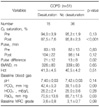Abstract
Background
The causes of exertional desaturation in patients with COPD can be multifactorial. We aimed to investigate factors predict exertional desaturation in patients with moderate to severe COPD.
Methods
We tested 51 consecutive patients with stable COPD (FEV1/FVC, 40±13% predicted). Patients performed a six minute walk test (6MWT). Pulse oxymetric saturation (SpO2) and pulse rate were recorded.
Results
Oxygen desaturation was found in 15 subjects after 6MWT, while 36 subjects were not desaturated. Lung diffusing capacity was significantly lower in desaturation (DS) group (62±18% predicted) compared with not desaturated (ND) group (84±20, p<0.01). However there was no statistical difference of FEV1/FVC ratio or residual volume between two groups. The pulse rate change was significantly higher in the desaturated compared with the not desaturated group. Six minute walking distance, subjective dyspnea scale, airflow obstruction, and residual volume did not predict exertional oxygen desaturation. Independent factors assessed by multiple logistic regression revealed that a pulse rate increment (odd ratio [OR], 1.19; 95% confidence interval [CI], 1.01~1.40; p=0.02), a decrease in baseline PaO2 (OR, 1.105; 95% CI, 1.003~1.218; p=0.04) and a decrease in lung diffusing capacity (OR, 1.10; 95% CI, 1.01~1.19; p=0.01) were significantly associated with oxygen desaturation. Receiver operator characteristic (ROC) analysis showed that an absolute increment in pulse rate of 16/min gave optimal discrimination between desaturated and not desaturated patients after 6MWT.
Figures and Tables
Figure 1
Correlation between the change in oxygen saturation and pulse rate before and after 6-minute walk test.

Figure 2
ROC curve of pulse rate change. Area under the ROC curve=0.704 (95% CI, 0.56 to 0.82). ROC: receiver operating characteristic; CI: confidence interval.

Table 1
Patient characteristics and pulmonary function data

*Mean±SD, †Chi-square test for comparison.
COPD: chronic pulmonary obstructive disease; DS: desaturated; ND: not desaturated; BMI: body mass index; FEV1: forced expiratory volume in one second; FEV1/FVC: forced expiratory volume to forced vital capacity ratio; RV: residual volume; DLCO: diffusing capacity of the lung for carbon monoxide; SD: standard deviation.
References
1. Reardon JZ, Lareau SC, ZuWallack R. Functional status and quality of life in chronic obstructive pulmonary disease. Am J Med. 2006. 119:10 Suppl 1. 32–37.
2. Weaver TE, Richmond TS, Narsavage GL. An explanatory model of functional status in chronic obstructive pulmonary disease. Nurs Res. 1997. 46:26–31.
3. Nonoyama ML, Brooks D, Guyatt GH, Goldstein RS. Effect of oxygen on health quality of life in patients with chronic obstructive pulmonary disease with transient exertional hypoxemia. Am J Respir Crit Care Med. 2007. 176:343–349.
4. Cote CG, Pinto-Plata V, Kasprzyk K, Dordelly LJ, Celli BR. The 6-min walk distance, peak oxygen uptake, and mortality in COPD. Chest. 2007. 132:1778–1785.
5. Nocturnal Oxygen Therapy Trial Group. Continuous or nocturnal oxygen therapy in hypoxemic chronic obstructive lung disease: a clinical trial. Ann Intern Med. 1980. 93:391–398.
6. Long term domiciliary oxygen therapy in chronic hypoxic cor pulmonale complicating chronic bronchitis and emphysema. Report of the Medical Research Council Working Party. Lancet. 1981. 1:681–686.
7. Wagner PD, Dantzker DR, Dueck R, Clausen JL, West JB. Ventilation-perfusion inequality in chronic obstructive pulmonary disease. J Clin Invest. 1977. 59:203–216.
8. West JB. Causes of carbon dioxide retention in lung disease. N Engl J Med. 1971. 284:1232–1236.
9. Owens GR, Rogers RM, Pennock BE, Levin D. The diffusing capacity as a predictor of arterial oxygen desaturation during exercise in patients with chronic obstructive pulmonary disease. N Engl J Med. 1984. 310:1218–1221.
10. Sue DY, Oren A, Hansen JE, Wasserman K. Diffusing capacity for carbon monoxide as a predictor of gas exchange during exercise. N Engl J Med. 1987. 316:1301–1306.
11. Hadeli KO, Siegel EM, Sherrill DL, Beck KC, Enright PL. Predictors of oxygen desaturation during submaximal exercise in 8,000 patients. Chest. 2001. 120:88–92.
12. Knower MT, Dunagan DP, Adair NE, Chin R Jr. Baseline oxygen saturation predicts exercise desaturation below prescription threshold in patients with chronic obstructive pulmonary disease. Arch Intern Med. 2001. 161:732–736.
13. Poulain M, Durand F, Palomba B, Ceugniet F, Desplan J, Varray A, et al. 6-minute walk testing is more sensitive than maximal incremental cycle testing for detecting oxygen desaturation in patients with COPD. Chest. 2003. 123:1401–1407.
14. Casanova C, Cote C, Marin JM, Pinto-Plata V, de Torres JP, Aguirre-Jaíme A, et al. Distance and oxygen desaturation during the 6-min walk test as predictors of long-term mortality in patients with COPD. Chest. 2008. 134:746–752.
15. Choi JK, Paek D, Lee JO. Normal predictive values of spirometry in Korean population. Tuberc Respir Dis. 2005. 58:230–242.
16. ATS Committee on Proficiency Standards for Clinical Pulmonary Function Laboratories. ATS statement: guidelines for the six-minute walk test. Am J Respir Crit Care Med. 2002. 166:111–117.
17. Torre-Bouscoulet L, Chávez-Plascencia E, Vázquez-García JC, Pérez-Padilla R. Precision and accuracy of "a pocket" pulse oximeter in Mexico City. Rev Invest Clin. 2006. 58:28–33.
18. Agustí AG, Noguera A, Sauleda J, Sala E, Pons J, Busquets X. Systemic effects of chronic obstructive pulmonary disease. Eur Respir J. 2003. 21:347–360.
19. Bradley JM, O'Neill B. Short-term ambulatory oxygen for chronic obstructive pulmonary disease. Cochrane Database Syst Rev. 2005. (4):CD004356.
20. Kelley MA, Panettieri RA Jr, Krupinski AV. Resting single-breath diffusing capacity as a screening test for exercise-induced hypoxemia. Am J Med. 1986. 80:807–812.
21. Ries AL, Farrow JT, Clausen JL. Pulmonary function tests cannot predict exercise-induced hypoxemia in chronic obstructive pulmonary disease. Chest. 1988. 93:454–459.
22. Ram FS, Wedzicha JA. Ambulatory oxygen for chronic obstructive pulmonary disease. Cochrane Database Syst Rev. 2002. (2):CD000238.




 PDF
PDF ePub
ePub Citation
Citation Print
Print





 XML Download
XML Download